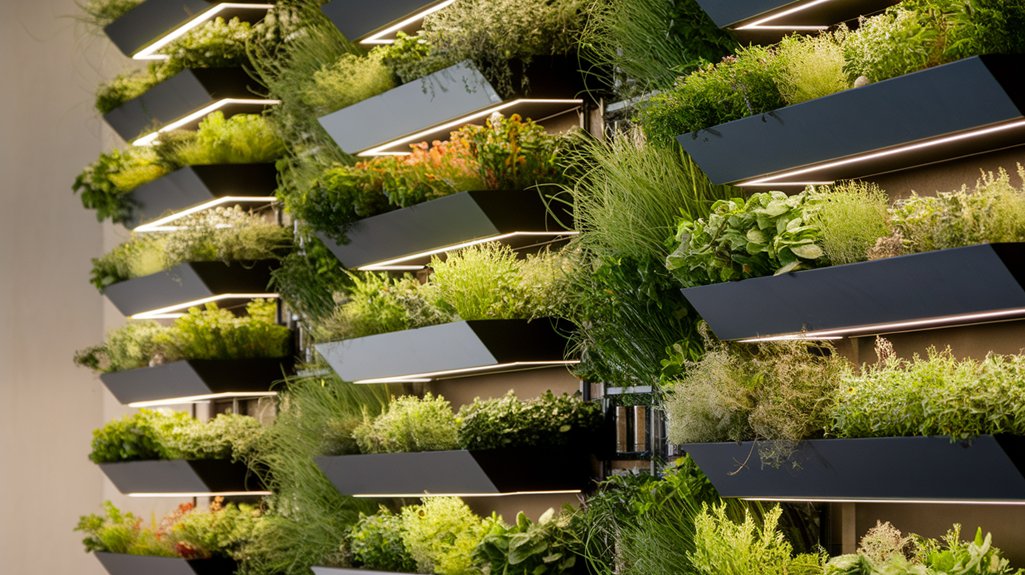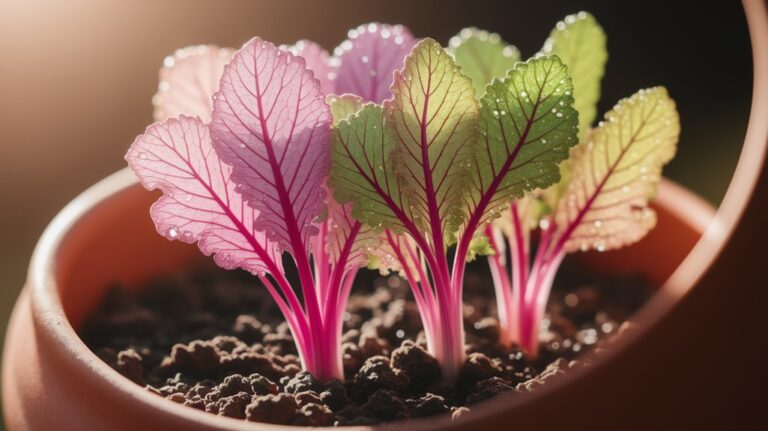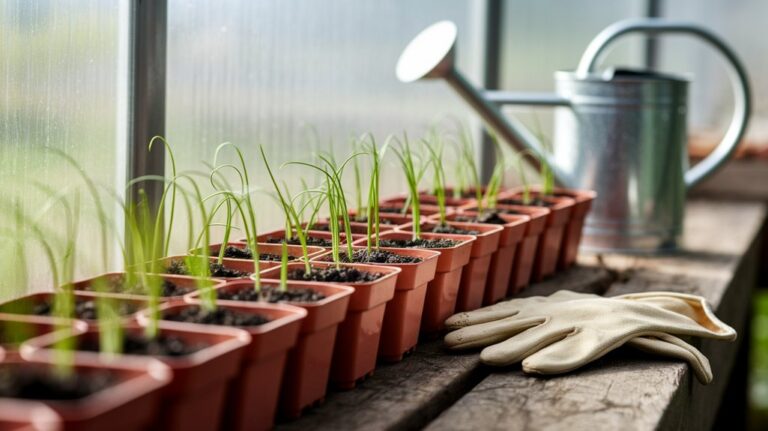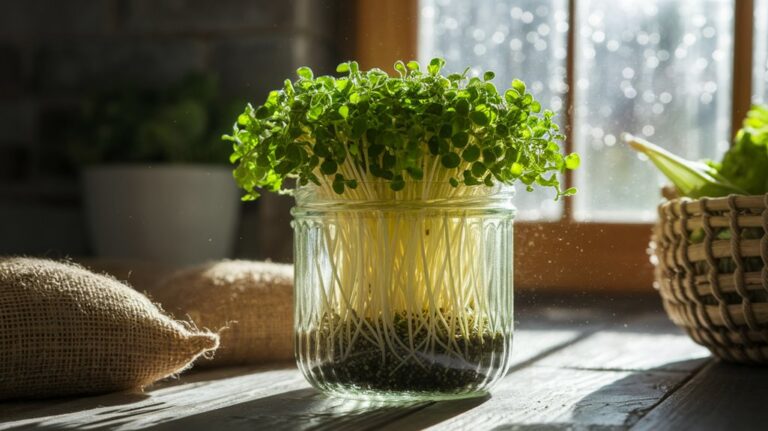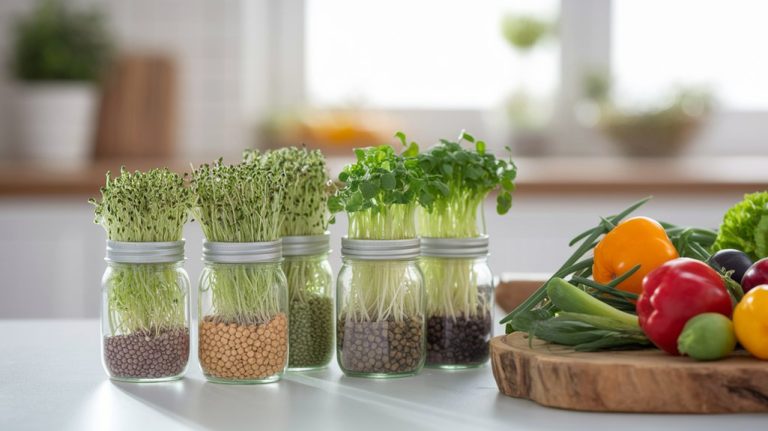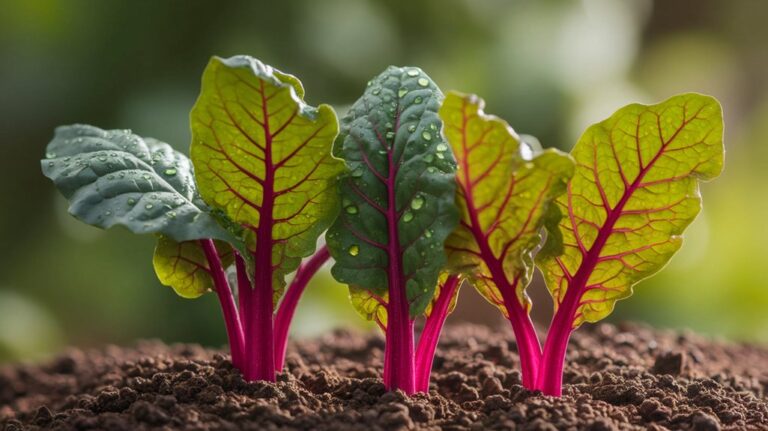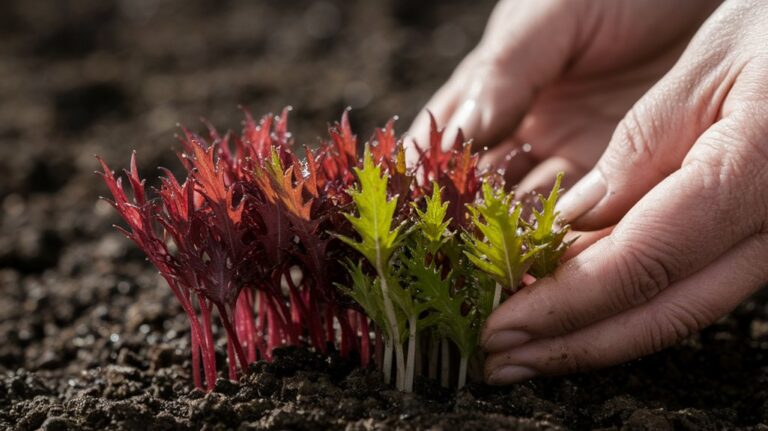Multi‑Layer Sprouting: Grow More in Less Space
Multi-layer sprouting lets me maximize my crop yields by strategically stacking plants in vertical layers, making it perfect for limited spaces. I can grow more in the same footprint by selecting compatible species with similar light and moisture needs. This approach not only increases productivity but also supports urban agriculture and sustainability. Understanding optimal conditions and maintenance techniques is key. If you’re curious about how to get started with your own setup, there’s more to explore.
Key Takeaways
- Utilize vertical layers to maximize space efficiency and increase crop yield in limited gardening areas.
- Select compatible crops with varying growth habits to optimize light and nutrient distribution among layers.
- Implement full-spectrum LED lighting to ensure all layers receive adequate light for healthy growth.
- Maintain a consistent watering schedule and monitor moisture levels to promote healthy sprout development.
- Employ effective pest management strategies, like beneficial insects and neem oil, to protect crops without harming them.
Understanding Multi-Layer Sprouting
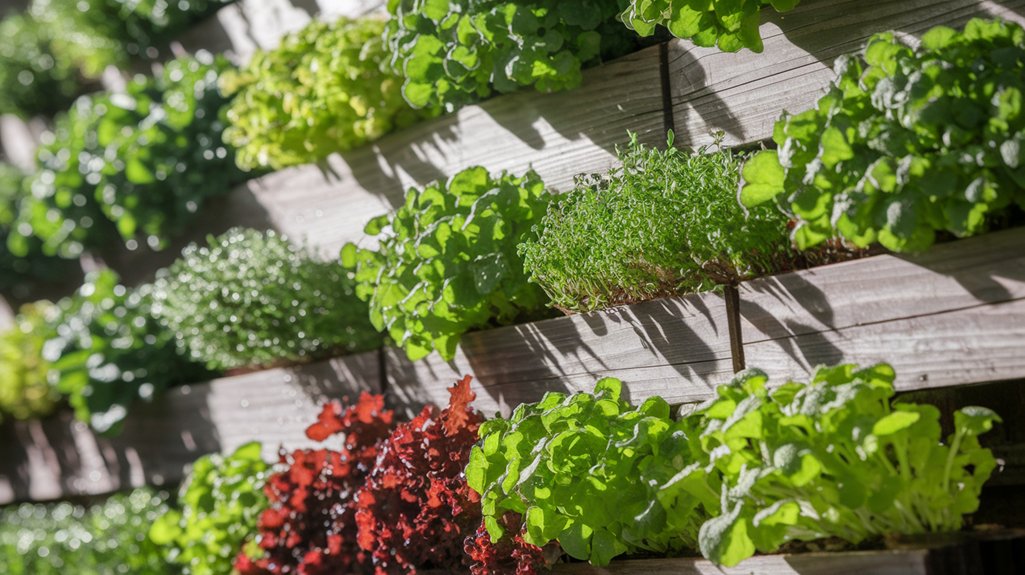
While exploring the concept of multi-layer sprouting, I’ve come to appreciate its potential in maximizing space and yield in both home and commercial gardening.
Multi-layer sprouting involves the strategic arrangement of various crops to grow in vertical layers, utilizing limited square footage effectively. By understanding the growth habits and light requirements of different plants, I can position them to thrive without competing for resources. This method relies heavily on selecting compatible species that can coexist harmoniously.
Additionally, I’ve noticed that incorporating various growth mediums and irrigation techniques can enhance nutrient delivery and moisture retention.
Ultimately, mastering multi-layer sprouting requires careful planning and monitoring, ensuring each layer contributes to an overall productive ecosystem within the garden.
Benefits of Multi-Layer Sprouting
In exploring the benefits of multi-layer sprouting, I find it crucial to highlight its space efficiency, which allows for optimal use of limited areas.
This method not only increases yield but also opens up diverse crop options, enhancing overall productivity.
Understanding these advantages can significantly impact how we approach urban agriculture and food sustainability.
Space Efficiency
As I explore the benefits of multi-layer sprouting, one standout advantage is its remarkable space efficiency.
Utilizing vertical space allows me to cultivate a variety of sprouts in compact areas, ideal for urban gardening or limited spaces. By stacking layers, I can maximize sunlight exposure while minimizing the footprint required for growth.
This technique also reduces competition among plants, optimizing airflow and light penetration. With careful planning, I can grow the same amount of produce that would typically require much larger horizontal space.
Multi-layer sprouting not only encourages innovative gardening practices but also aligns with sustainable living, making it a practical choice for those looking to enhance their food production without sacrificing valuable real estate in their homes or communities.
Increased Yield
Maximizing vertical space through multi-layer sprouting directly contributes to increased yield, a compelling benefit for anyone looking to optimize their gardening efforts.
By layering plants, I can grow a greater quantity within the same footprint, effectively utilizing resources like light, water, and nutrients. Each layer can be tailored to specific growth requirements, ensuring that plants thrive without competing excessively.
This method not only enhances productivity but also allows for staggered harvests, which means I can enjoy fresh produce over an extended period.
Moreover, the microclimate created by multiple layers can lead to improved growth conditions, further boosting yield.
Ultimately, this technique transforms limited space into a powerhouse of productivity, making it an invaluable strategy for any gardener.
Diverse Crop Options
Multi-layer sprouting offers a remarkable variety of crop options that can enhance both the nutritional diversity and culinary potential of my garden.
By employing this technique, I can grow an array of sprouts, such as radish, sunflower, and pea shoots, all within limited space. Each layer in my sprouting system allows for different light and moisture levels, which means I can optimize growth conditions for each type of crop.
This not only increases yield but also enables me to experiment with flavors and textures in my meals. Furthermore, diverse sprouts are packed with vitamins, minerals, and antioxidants, contributing to a healthier diet.
Ultimately, multi-layer sprouting empowers me to cultivate a more dynamic and nutritious garden.
Essential Supplies for Your Setup
While embarking on a multi-layer sprouting project, it’s crucial to gather the right supplies that will ensure a successful setup.
Having the correct equipment not only maximizes your yield but also simplifies the process. Here’s what I recommend you prioritize:
- Growing trays: Look for stackable trays with drainage holes for optimal water management.
- Lighting: Invest in full-spectrum LED grow lights to support healthy growth.
- Growing medium: Use high-quality soil or a hydroponic medium that retains moisture while allowing for good aeration.
- Watering system: A simple misting system or a spray bottle can help maintain humidity without overwatering.
With these essentials, you’ll be well on your way to creating a thriving multi-layer sprouting environment.
Step-by-Step Guide to Getting Started
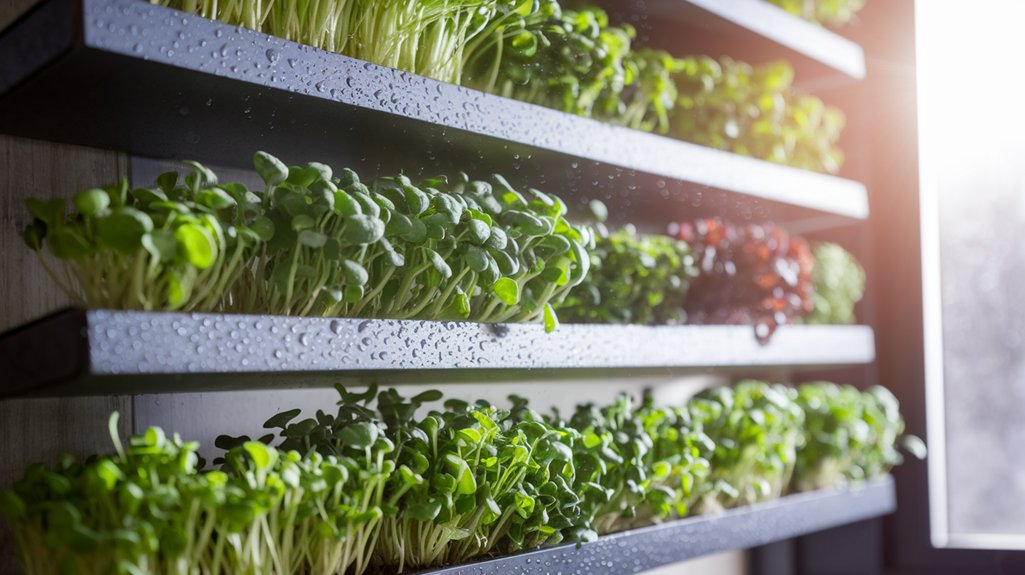
To successfully embark on your sprouting journey, I recommend starting with a clear plan that outlines each step of the process.
First, select a suitable location with adequate light and temperature control. Gather your supplies, including trays, soil, and seeds.
Next, layer your trays, ensuring proper drainage in each layer to prevent overwatering. When you’re ready, soak your seeds according to their specific requirements and distribute them evenly across the soil.
Maintain consistent moisture and monitor the temperature, adjusting as necessary. Regularly check for signs of growth and pests.
Once your sprouts reach the desired height, harvest them carefully to avoid damaging the roots. By following these steps, you’ll create a thriving multi-layer sprouting system.
Best Crops for Multi-Layer Sprouting
Choosing the right crops is crucial for successful multi-layer sprouting, and I’ve found that certain varieties excel in this environment.
When selecting, consider crops that thrive in close quarters and have quick growth cycles. Here are my top picks:
- Lettuce: Fast-growing and compact, perfect for upper layers.
- Radishes: They germinate quickly and can fit snugly between other crops.
- Basil: Thrives in a warm environment, adding flavor and fragrance.
- Microgreens: These nutrient-dense plants grow rapidly and don’t require much space.
Tips for Maintenance and Care
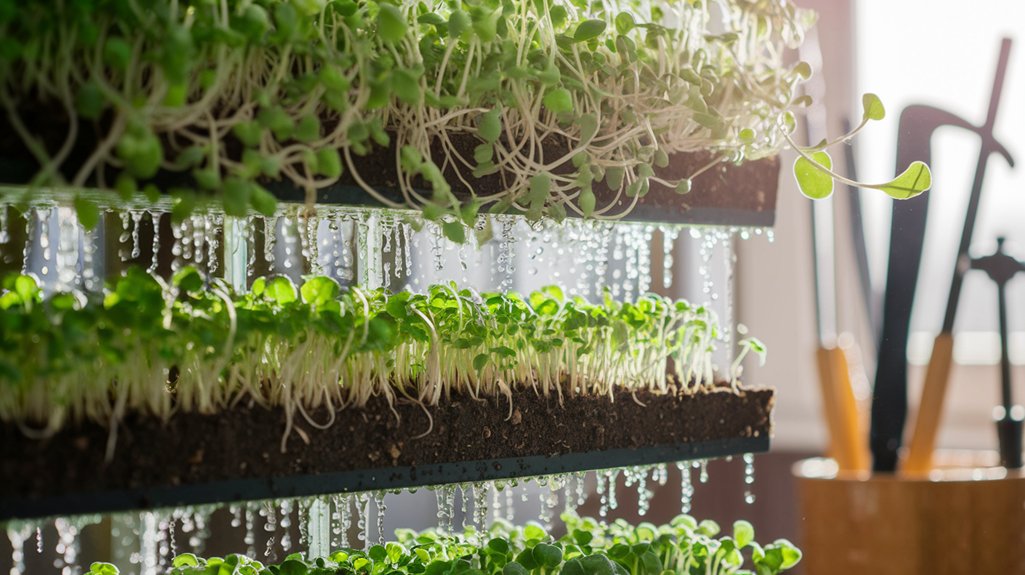
As I focus on maintaining my multi-layer sprouts, I’ve found that a consistent watering schedule is crucial to their growth.
Additionally, ensuring optimal light conditions helps maximize their potential, while implementing effective pest management strategies keeps them healthy.
Understanding these elements can significantly enhance the success of my sprouting efforts.
Watering Schedule Essentials
While maintaining a consistent watering schedule may seem straightforward, it’s crucial for the health of your multi-layer sprouts.
I’ve found that striking the right balance can make a significant difference in growth and yield. Here are some essentials to consider:
- Frequency: Water daily, adjusting based on humidity and temperature.
- Amount: Ensure soil is moist but not soggy; overwatering can lead to root rot.
- Timing: Water in the morning to allow absorption before peak sunlight.
- Monitoring: Check moisture levels by sticking your finger into the soil; if it feels dry, it’s time to water.
Optimal Light Conditions
How can you ensure your multi-layer sprouts receive the optimal light they need for robust growth? First, I recommend using full-spectrum LED grow lights, which mimic natural sunlight and promote photosynthesis effectively.
Position these lights about 12 to 24 inches above your sprouts, adjusting the height as they grow. Aim for 12 to 16 hours of light daily, as this duration optimizes growth without causing stress.
Monitor the temperature; it should ideally stay between 70°F and 80°F, as extreme heat can hinder sprouting.
Moreover, rotating your trays weekly can help ensure even light distribution, preventing your sprouts from leaning towards the source.
Pest Management Strategies
After ensuring optimal light conditions for your multi-layer sprouts, managing pests becomes a vital aspect of maintaining their health and productivity.
I’ve found that implementing effective pest management strategies is crucial in preventing infestations and ensuring robust growth. Here are some strategies I recommend:
- Regular Monitoring: Check your sprouts daily for any signs of pests or disease.
- Natural Predators: Introduce beneficial insects like ladybugs to keep harmful pests in check.
- Neem Oil: Use neem oil as a natural pesticide to deter common pests without harming your sprouts.
- Sanitation: Keep your growing area clean by removing debris and dead plants to reduce pest habitats.
Troubleshooting Common Issues
As I delve into troubleshooting common issues with multi-layer sprouting, it’s essential to recognize that various factors can hinder the success of your sprouting efforts.
One frequent problem I encounter is uneven moisture distribution. Make sure each layer receives adequate water; too much or too little can lead to mold or stunted growth.
Additionally, inadequate light exposure can result in weak sprouts. I’ve found that positioning your setup near a light source or using grow lights can significantly improve results.
Another issue is temperature; maintaining a consistent, warm environment is crucial for germination.
Lastly, be vigilant about pests, as they can disrupt the delicate balance of your system. Regular monitoring and adjustments can help you achieve a thriving multi-layer sprouting garden.
Frequently Asked Questions
Can I Use Any Type of Seeds for Multi-Layer Sprouting?
When considering seeds for multi-layer sprouting, I’ve found that not all seeds are suitable.
While some, like alfalfa and radish, thrive in this setup, others may not sprout effectively or could require more space.
I’ve experimented with various seeds and discovered that smaller, faster-growing varieties generally perform best.
Always check the specific requirements for each seed type to ensure a successful sprouting experience and maximize your yield in limited space.
How Much Light Do the Sprouts Need Daily?
I’ve found that sprouts generally need around 12 to 16 hours of light daily for optimal growth.
If you’re using artificial lighting, it’s crucial to maintain a consistent light schedule. Natural light can also work, but make sure your sprouts aren’t too far from the window.
I’ve noticed that too little light can lead to leggy growth, so don’t underestimate the importance of proper lighting in your sprouting process.
What Is the Ideal Temperature for Sprouting?
The ideal temperature for sprouting generally ranges between 65°F and 75°F (18°C to 24°C).
I’ve found that maintaining this temperature helps maximize germination rates and encourages healthy growth.
If it dips below 60°F (15°C) or rises above 80°F (27°C), sprouting can slow down or become inconsistent.
I always monitor the temperature closely to ensure my sprouts thrive, as this small adjustment can significantly impact their development.
Can I Stack Different Crops in One Setup?
Absolutely, you can stack different crops in one setup, but it requires careful planning.
I’ve found that compatibility in growth rates and light requirements is crucial. For example, pairing fast-growing crops with slower ones can maximize efficiency.
I also ensure that taller plants don’t shade shorter ones. By monitoring moisture and nutrient needs, I can create a harmonious environment where all plants thrive, ultimately enhancing my overall yield.
How Often Should I Harvest From My Multi-Layer Setup?
I recommend harvesting every 7 to 14 days, depending on the growth rate of your crops.
Regular harvesting encourages continued growth and prevents overcrowding.
I’ve found that keeping an eye on the plants’ development helps me determine the right time to cut.
It’s essential to maintain a balance, ensuring that I don’t remove too much at once, which could stunt growth.
Consistent monitoring and timely harvesting have yielded better results for me.
Conclusion
In conclusion, multi-layer sprouting is an innovative method that maximizes space while enhancing your crop yield. By understanding the benefits and following the essential steps, I’ve found it’s both efficient and rewarding. With the right supplies and a little care, anyone can successfully cultivate a variety of crops in limited areas. As we embrace this technique, we can transform urban gardening and contribute to sustainable food practices. Dive in, and watch your green space flourish.

